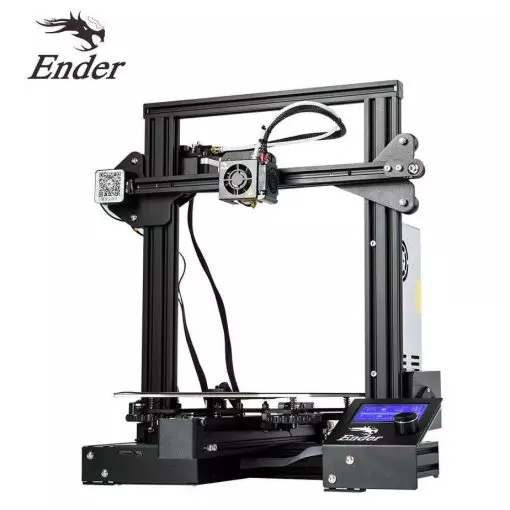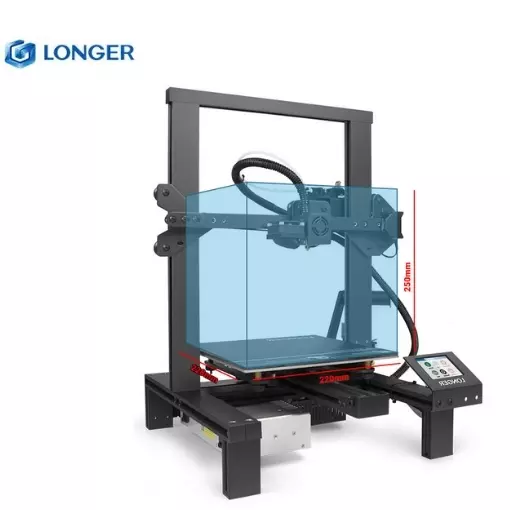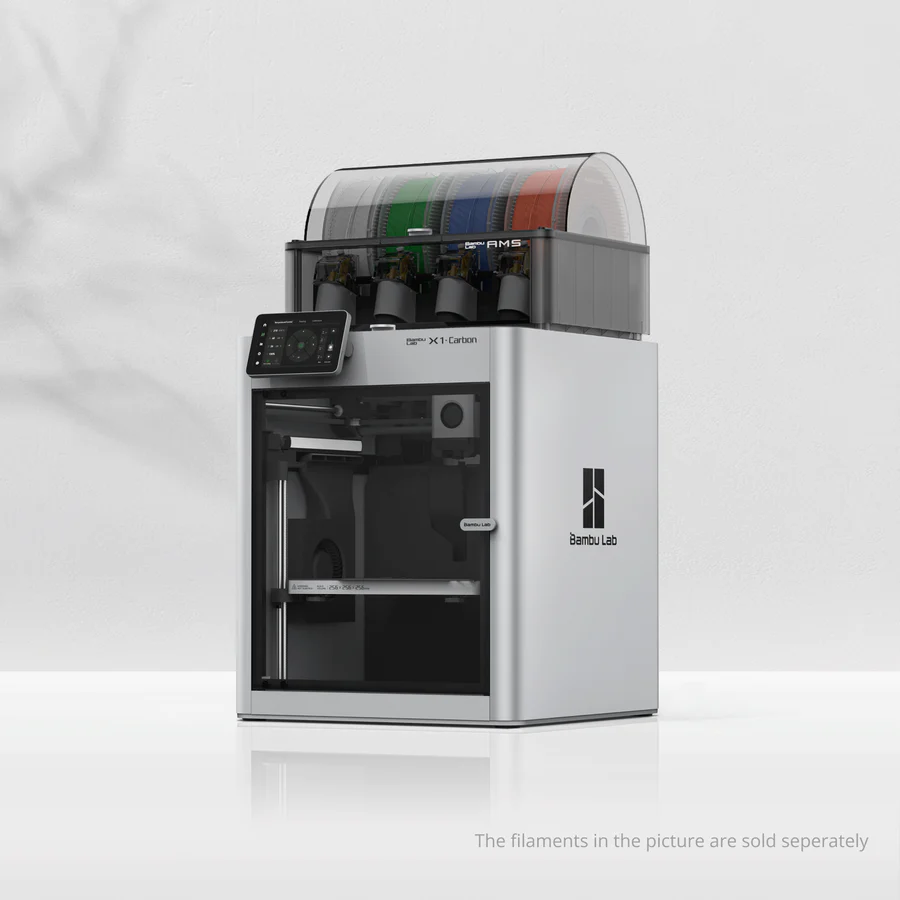Compare Ender 3 vs LK4 vs X1 carbon
Comparison between the best 3D printers
Choose the best 3D printer at the best price. The cheapest 3D printers are here.
Buy a 3D printer here with 3D Fila.
 |
 |
 |
|
| Model | Ender 3[BUY Ender 3] |
LK4 |
X1 carbon |
| Printing Material | Filament | Filament | Filament |
| Estimated price | $210,00 | $200,00 | $1449,00 |
| Fabricante | Creality 3D | Longer 3D | Bambu Lab |
| Release Year | 2018 | 2019 | 2023 |
| Print Volume [mm] | 220x220x250 | 220x220x250 | 256x256x256 |
| Printer Size [mm] | 440x440x465 | 402x425x505 | 389x389x457 |
| Weight [kg] | 6,62 | 7,8 | 14,13 |
| Power Loss Recovery | NO | YES | YES |
| Enclosed printer | NO | NO | NO |
| Bed Leveling | Manual | Manual com Assistência | Automatic |
| Filament End Sensor | NO | YES | YES |
| Bed type | Heated | Heated | Heated |
| Power supply system | Bowden | Bowden | Direct Drive |
| Standard nozzle | 0,4 | 0,4 | 0,4 |
| Maximum Nozzle Temperature [°C] | 255 | 250 | 300 |
| Maximum Bed Temperature [°C] | 110 | 100 | 120 |
| Maximum printing speed [mm/s] | 180 | 120 | 500 |
| Filament holder | YES | YES | YES |
| Camera for supervision | NO | NO | YES |
| Recommended filaments | PLA, TPU, ABS, PETG | PLA, TPU, ABS, PETG | PLA, PETG, TPU, PVA, PA, PA-CF, Nylon, PC |
| Recommended slicers | Cura, Simplify, Slic3r | Cura, Simplify, Slic3r | Bambu Studio, Super Slicer, Cura, Prusa Slicer, Orca |
| Maximum Resolution [mm] | 0,1 | 0,1 | 0,1 |
| Processor | 8 bits | 8 bits | Quad ARM A7 1.2 GHz |
| Display | Mono | Touchscreen TFT 2,8'' | Touchscreen 5'' |
| Power Supply | 24V / 270W | 12V / 360W | 350 W |
| Connectivity | SD / USB | SD / USB | Wifi, Bambu bus, Cartão SD |
| Operating systems | Windows, Mac, Linux | Windows, Mac, Linux | Windows, Linux, Macbook |
| Date of registration in the system | 2021-04-13 | 2021-04-15 | 2024-04-10 |
| Release date | 2018 | 2019 | 2023 |
| Extra features | The Ender 3 V1 is a DIY assembly 3D printer, a sales leader since 2017, standing out for its cost-benefit. With a wide printing capacity, it has a CNC machined structure for precision and stability. It offers high-precision prints with low noise, thanks to its innovative V-profile and pulleys. It has a self-adhesive magnetic platform for easy removal of models and excellent adhesion. The Ender 3 heats up quickly, reaching 100°C in 5 minutes, ideal for agile prints. It includes protection against power failures, allowing you to resume printing after interruptions, saving time and material. | The Longer LK4 is a versatile 3D printer capable of working with a wide range of filaments, such as PLA, ABS, TPU, copper, wood and carbon fiber, thanks to its 0.4mm nozzle and heated bed up to 110°C. With a printing accuracy of between 0.05-0.4mm, it stands out for its solid construction with an aluminum frame, weighing around 7kg, and a robust 24V and 15A power supply. The kit includes an Allen key, a 7/10 key, a microSD card with USB adapter, a spatula, cable ties, a power cable, 5m of filament and a spare filament end sensor. Assembly is simplified, with around 90% of the equipment pre-assembled, and detailed instructions assist in the process. Special features include print recovery after power failure, a filament end sensor, a super-adhesive printing surface and an intuitive color touchscreen display. The design features smooth profiles for easy assembly, and the position of the filament holder optimizes the filament path to the extruder. The LK4 is a solid choice for 3D printing enthusiasts looking for quality and versatility. | The Bambu Lab X1 Carbon revolutionizes 3D printing with stunning design, high print speeds, and a streamlined user experience. It stands out with its CoreXY system, a hotend capable of reaching 300°C, allowing for a wide range of filaments. Its LiDAR-assisted bed leveling system, vibration compensation, and AMS multicolor printing capability raise the industry standard. Print quality is impressive, with the ability to fine-tune for perfection. The X1 Carbon, with its closed build volume, not only promises but also delivers one of the most advanced 3D printing experiences available to consumers. |
| Support for multiple colors and materials (AMS and CFS) | NO | NO | YES |
Notes * |
|||
| Cost-benefit | 6 / 10 | 7 / 10 | 7 / 10 |
| Hardware | 0.5 / 10 | 2 / 10 | 6.4 / 10 |
| Screen | . | . | . |
| Print volume | 3 / 10 | 3 / 10 | 4 / 10 |
| Performance | 1 / 10 | 1 / 10 | 4 / 10 |
| [BUY Ender 3] |
Conclusion |
| In conclusion, the comparison of the Ender 3, Longer LK4, and Bambu Lab X1 Carbon highlights significant differences in functionality, utility, and price that cater to different types of users. The **Ender 3**, known for its reputation as a cost-effective entry-level printer, offers essential features such as a decent print volume and high precision while lacking advanced functionalities like power-loss recovery. Its DIY assembly nature makes it suitable for those comfortable with some hands-on setup, but its basic functionality might limit more seasoned users seeking enhanced performance. The **Longer LK4** slightly raises the bar with its added features like power-loss recovery and a filament end sensor, making it more user-friendly and reliable for continuous printing. It offers a good balance of print quality and versatility with a range of supported filaments, appealing to hobbyists looking to experiment with different materials while maintaining a reasonable price. On the other hand, the **Bambu Lab X1 Carbon** represents the cutting edge of 3D printing technology with its advanced features such as automatic bed leveling, high-speed printing capabilities, and support for a wide variety of materials. While it comes at a significantly higher price, it caters to professionals or serious enthusiasts who demand exceptional performance and quality. Ultimately, the choice among these 3D printers depends on the user’s budget and intended usage. For budget-conscious beginners, the Ender 3 remains a solid choice. In contrast, the Longer LK4 provides a more intermediate option with several upgrades, while the Bambu Lab X1 Carbon stands out as a premium investment for advanced users seeking top-tier capabilities. Each model delivers unique advantages tailored to different needs within the 3D printing community. |

